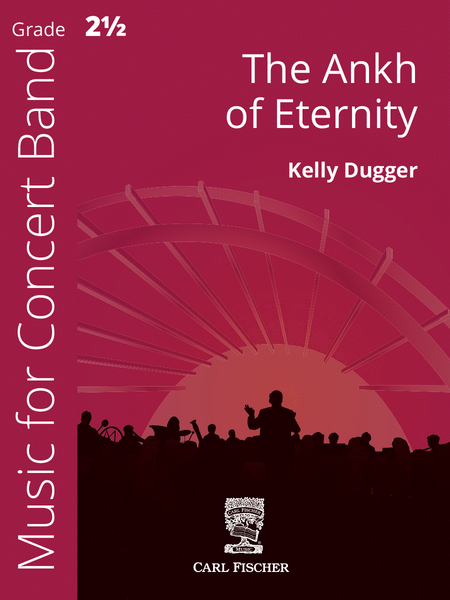Details
Description
SKU: CF.YPS240
Composed by Kelly Dugger. Set of Score and Parts. 24+8+8+4+8+8+4+4+6+4+4+4+8+8+8+6+6+6+4+6+2+4+6 pages. Duration 5 minutes, 20 seconds. Carl Fischer Music #YPS240. Published by Carl Fischer Music (CF.YPS240).ISBN 9781491159637. UPC: 680160918225.
An Ankh is an ancient Egyptian hieroglyphic representing the word "Life." The Ankh of Eternity depicts an epic journey through ancient lands to find the mythical Ankh of Eternity amulet promising eternal life. The piece journeys through the desert in a caravan, with a stop for a Kaff celebration, an Arabic hand-clapping folk art. The discovery of the tomb is spine chilling and eerie with special percussion effects. After the Ankh is discovered, swarms of locusts descend and our travelers run for their lives. They may have found eternal life, but will they be forever cursed? The Ankh of Eternity uses an Arabic or double harmonic-major scale. Performers have multiple soloing and improvising opportunities. Complex but repeating rhythms offer players a chance to practice getting in the groove. Players and audiences alike will be invigorated by the many celebratory moments and thrilled at the eerie and downright scary moments! The Ankh of Eternity offers cultural and historical inclusion opportunities, improvisation, unique scales, rhythmic challenges, and a thrilling story. Conductor Notes: Measures 45-61: Kaff is the ancient Arabic art of hand clapping over improvised poetry. The "Kaff Celebration" section represents this art form. The improvising soloists should be designated by the conductor and should each be four measures long . Alternatively, soloists may copy the phrase in the second ending as a solo. The "AYE!" should be shouted joyously. The repeat may be omitted for performance time concerns, or, of course, repeated multiple times for more solos. Measures 64-73: Experiment with different cymbal noises, such as scrapes with a nail or coin, taps with triangle beaters, bowed cymbals, etc. Water-cymbal techniques should also be used. Fill a storage tub with water, and with the suspended cymbal still on the stand, hit the cymbal a couple times with a soft mallet, and lower the cymbal into the water for a glissando effect. The overall effect should be creepy cave-like echoes bending around corners.
An Ankh is an ancient Egyptian hieroglyphic representing the word "Life." The Ankh of Eternity depicts an epic journey through ancient lands to find the mythical Ankh of Eternity amulet promising eternal life. The piece journeys through the desert in a caravan, with a stop for a Kaff celebration, an Arabic hand-clapping folk art. The discovery of the tomb is spine chilling and eerie with special percussion effects. After the Ankh is discovered, swarms of locusts descend and our travelers run for their lives. They may have found eternal life, but will they be forever cursed?The Ankh of Eternity uses an Arabic or double harmonic-major scale. Performers have multiple soloing and improvising opportunities. Complex but repeating rhythms offer players a chance to practice getting in the groove. Players and audiences alike will be invigorated by the many celebratory moments and thrilled at the eerie and downright scary moments! The Ankh of Eternity offers cultural and historical inclusion opportunities, improvisation, unique scales, rhythmic challenges, and a thrilling story.Conductor Notes: Measures 45–61: Kaff is the ancient Arabic art of hand clapping over improvised poetry. The "Kaff Celebration" section represents this art form. The improvising soloists should be designated by the conductor and should each be four measures long . Alternatively, soloists may copy the phrase in the second ending as a solo. The "AYE!" should be shouted joyously. The repeat may be omitted for performance time concerns, or, of course, repeated multiple times for more solos. Measures 64–73: Experiment with different cymbal noises, such as scrapes with a nail or coin, taps with triangle beaters, bowed cymbals, etc. Water-cymbal techniques should also be used. Fill a storage tub with water, and with the suspended cymbal still on the stand, hit the cymbal a couple times with a soft mallet, and lower the cymbal into the water for a glissando effect. The overall effect should be creepy cave-like echoes bending around corners.

 Share
Share